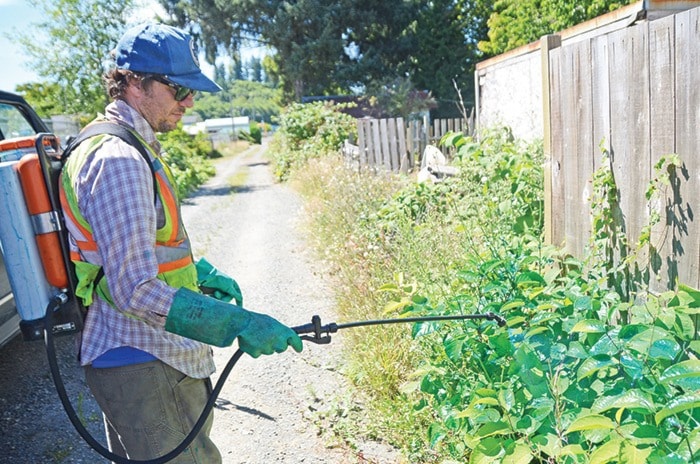If some of the flagging tape currently up around town reminds you of the ropes of a boxing ring, it might be because much of it has been put up by the City of Campbell River and Greenways Land Trust to mark off the areas that play host to their latest fight with Japanese knotweed in the area.
“The plan of attack this year is similar to what we've done in the past,” says Greenways’ new summer student, Josephine Simpson, a Carihi graduate currently in her fourth year of environmental studies at the University of Victoria.
“The only known effective treatment of knotweed is herbicide treatment by specialists, which usually needs to be repeated for two to three years in order to prevent regrowth,” Simpson says. “So our priority is treating those sites that we've treated previously, so that we can actually eliminate the infestations, and treating new infestations that are close to re-treatment sites.”
They will also be focusing their efforts on environmentally sensitive areas, such as watersheds.
“We're very concerned about the impacts of knotweed on fish habitat,” Simpson says. “In the estuary, for example, knotweed would outcompete native sedges, rushes, and grasses, which provide important food and shelter for many species. The loss of these plant communities to a knotweed infestation also effects the stability of the bank – knotweed does not effectively protect against erosion. We try to catch infestations close to sensitive areas quickly, because once they're established within a metre of the water, we can't apply the herbicide.”
But they won’t only be treating environmentally sensitive areas. They will also be attacking the weed near residences and businesses where the roots of the plant can cause damage.
“There are places in England where you can’t get a mortgage if there’s knotweed on the property, because the stuff can just tear apart foundations,” Simpson says. “It’s very destructive when it gets active.”
Simpson says she’s personally looking forward to the challenge and is excited to be a part of the process as the Greenways summer student this season.
“Greenways' student position was a great opportunity for me to actually work within the field,” she says. “The work is engaging in a way that say, washing dishes, never would be; I get to be involved with projects that excite me.”
She says she’s not sure what she’ll be getting into, exactly, once she graduates from UVic, “but there's a lot of exciting stuff happening in the environmental non-profit sector so it's great to be able to see the ground work involved in running a non-profit.”
If you have knotweed on your property, you may be eligible to receive free treatment. To get on the waitlist or receive further information, including how to deal with your infestation while waiting for treatment, phone the Greenways Land Trust at 250-287-3785 or email greenways@greenwaystrust.ca.
Though this year’s program is already underway, they may be able to treat sites reported to them before July 31st, so they suggest people look around their yards for signs of the weed as soon as possible.
For help identifying a potential knotweed infestation, visit bcinvasives.ca and look for the “identify” tool in the “Invasive Species” menu.
